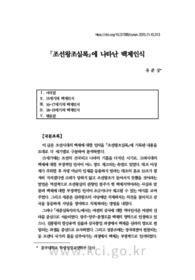

PARTNER
검증된 파트너 제휴사 자료
『조선왕조실록』에 나타난 백제인식 (Based on the Baekje awareness in the Annals of the Joseon Dynasty)
42 페이지
최초등록일 2025.05.08
최종저작일
2025.01

-
미리보기
서지정보
· 발행기관 : 북악사학회
· 수록지 정보 : 북악사론 / 21호 / 313 ~ 354페이지
· 저자명 : 유준상
초록
이 글은 조선시대의 백제에 대한 인식을 조선왕조실록에 기록된 내용을토대로 각 세기별로 구분하여 분석하였다.
15세기에는 조선의 건국되고 나라의 기틀을 다지던 시기로, 고려시대의백제에 대한 부정적인 인식이 어느 정도 재고되는 측면도 있었다. 태조 이성계가 즉위한 후 차령 이남의 인재를 등용하지 말라는 태조의 훈요 10조가 철저히 지켜졌다면 고려가 망하지 않고 조선왕조가 들어서지 못했을 것이라는발언은 역설적으로 조선왕실의 관향인 전주가 옛 백제지역이라는 사실과 맞물려 백제에 대한 부정적인 인식이 조금이나마 재고될 수 있는 여지를 보여주었다. 그리고 세종은 신라왕조의 사당에만 치제하자는 의견을 물리치고 삼국을 동등하게 사당을 정비하고 치제하라는 명령을 내렸다.
그러나 세종실록지리지에서는 여전히 삼국에 대한 역사인식은 여전히 신라를 중심으로 서술되었다. 광주・양주・충청도를 백제의 영역으로 인정하고 있으나, 진흥왕의 한강유역 진출과 삼국통일 과정에서 백제를 신라의 영토로 편입되는 과정을 중심으로 묘사하였다. 그리고 성종조에는 경국대전이 편찬되는등 조선이 국가의 틀을 갖추어가는 과정에서 백제는 부정적으로 인식되었다.
그러나 16세기로 들어서면서 사림의 진출과 사화의 극복을 계기로 백제성충의 충심이 부각되기 시작했다. 이후 선조의 즉위를 전후로 한 시점에서사림이 정국을 주도함에 따라 백제는 계백과 성충의 충절이 긍정적으로 재평가 받게 되었다. 그리고 임진왜란이라는 국가적 위기상황을 맞이하여 성충과계백과 같은 국가에 충심을 바친 인물들이 조명되고, 남한산성이 수도방어의요지로 주목받으며 백제의 옛 수도라는 점이 부각되기 시작했다.
17세기에는 남한산성에 수어청이 설치되는 등 남한산성이 중요한 방어시설로 인식되었다. 아울러 병자호란 이후에는 남한산성에 백제 시조 온조왕의사당을 짓고 관리하였으며, 남한산성 축성의 책임자인 이서를 함께 배향하였다. 이는 병자호란 이후 조선왕실과 지식인들은 북벌론의 대두와 같은 반청의식의 경향을 보였다. 그리고 옛 남한산성의 주인이라 여겨지던 백제의 시조 온조왕에 대한 존숭의식을 투영시키며 백제에 대한 관심을 이끌어가는 모습을 보였다.
18세기 이후로는 북한산성의 수축으로 조선후기 남한산성, 강화돈대와 함께 수도방어의 체제가 마련되고 조선과 청나라간의 정축약조라는 외교적 문제를 해결되는 등 조선후기의 정치, 군사, 외교적 성과가 나타났다. 아울러사학사적 측면을 생각할 때 북한산성의 축성을 추진했던 근거의 하나가 백제근초고왕 때 이루어진 천도였다는 점도 지나칠 수는 없는 요소였다.
이를 통해 병자호란 이후 북벌론과 반천의식의 대두와 함께 백제의 시조에 대한 예우가 지속되고 이는 백제에 대한 인식이 상향되는 경향이 있음을알 수 있다. 이와 같은 경향은 영・정조대에도 이어졌다. 영조는 고려왕조의옛 능과 단군, 기자, 신라, 고구려, 백제 시조의 능을 수축하라고 명하였고 정조대에는 백제 시조의 묘호를 숭렬전으로 격상시키기에 이른다.
조선왕조에 들어 백제에 대한 역사인식은 15세기 조선의 건국, 16세기 사림정치의 전개와 임진왜란을 배경으로 성충・계백의 충절에 대한 부각, 17세기 병자호란을 전후로 한 남한산성 수축 및 온조와 이서의 배향, 18세기 북한산성의 수축과 백제묘호의 격상 등으로 점차 상향되는 경향을 보인다. 그리고 나아가 18세기 이후 다양한 사서의 출현과 19세기 북학의 발달로 인한발해고의 편찬으로 나아가며 한국사학사의 발전에 원동력이 되었다.영어초록
This article classified and analyzed the perception of Baekje in the Joseon Dynasty by each century based on the contents recorded in the Annals of the Joseon Dynasty.
In the 15th century, Joseon was founded and the foundation of the country was laid, and the negative perception of Baekje in the Goryeo Dynasty was somewhat reconsidered. Paradoxically, the statement that if Taejo's 10th Article of King Taejo's decree not to appoint talents south of Chaeryeong had been thoroughly followed after Taejo Lee Seong-gye ascended the throne, the Joseon Dynasty would not have been established without Goryeo's collapse, was combined with the fact that Jeonju, the Joseon royal family's official residence, was a former Baekje region, and showed room for a little reconsideration of the negative perception of Baekje. Sejong rejected the opinion that only the Silla Dynasty should be memorialized, and ordered the three kingdoms to be renovated and reigned equally.
However, in 「Sejong Silokjiri」, the historical perception of the three countries is still described around Silla. Although Gwangju, Yangju, and Chungcheong Province are recognized as Baekje's territory, it was described focusing on the process of King Jinheung's entry into the Han River basin and the unification of the three countries, which led to Baekje's incorporation into Silla's territory. In addition, Baekje was perceived negatively in the process of establishing the national framework for Joseon, such as the compilation of the Gyeongguk Daejeon in King Seongjong's reign.
However, in the 16th century, the loyalty of Baekje's adults began to emerge as a result of Sarim's advance and the overcoming of the private life. Later, around the time of King Seonjo's accession, Sarim led the political situation, and Baekje's loyalty to Gyebaek and Seongchung was positively reevaluated. In the face of the national crisis of Imjin War, the figures who devoted themselves to the state, such as the adult and Gyebaek, were highlighted, and Namhansanseong Fortress was noted as the main point of capital defense, and the former capital of Baekje began to emerge.
In the 17th century, Namhansanseong Fortress was recognized as an important defense facility, such as the establishment of a sign language office at Namhansanseong Fortress. In addition, after the Byeongja Horan, a shrine to King Onjo, the founder of Baekje, was built and managed at Namhansanseong Fortress, and Lee Seo, the head of the Namhansanseong Fortress construction, was oriented together. After the Byeongja Horan, the Joseon royal family and intellectuals showed the same tendency of anti-Cheongui style as the rise of Northern Beolon. In addition, it showed a sense of respect for the founder of Baekje, King Onjo, who was considered the owner of the former Namhansanseong Fortress, and led interest in Baekje.
Political, military, and diplomatic achievements of the late Joseon Dynasty were achieved after the 18th century, such as the establishment of a system of capital defense along with Namhansanseong and Ganghwa Dondae in the late Joseon Dynasty due to the contraction of Bukhansanseong Fortress. In addition, it cannot be overlooked that one of the grounds for promoting the construction of Bukhansanseong Fortress during the reign of King Geunchogo of Baekje was Cheondo.
Through this, it can be seen that after the Byeongja Horan, with the rise of the Northern Verbal theory and the anti-Cheon ritual, the respect for the founder of Baekje continued, and this tended to raise awareness of Baekje.
This trend continued in the Yeong and Jeongjo periods. Yeongjo ordered the old tombs of the Goryeo Dynasty, Dangun, Gija, Silla, Goguryeo, and Baekje to be reduced, and during the Jeongjo period, the Myoho of the founder of Baekje was upgraded to Sungryuljeon.
In the Joseon Dynasty, the historical perception of Baekje gradually increased due to the founding of Joseon in the 15th century, the development of Sarim politics in the 16th century, and the rise of loyalty of adults and Gyebaek against the backdrop of the Imjin War, the contraction of Namhansanseong Fortress and the orientation of Onjo and Iseo around the 17th century Byeongja Horan, the contraction of Bukhansanseong Fortress in the 18th century, and the elevation of Baekje Myoho. Furthermore, after the 18th century, with the emergence of various librarians and the development of Bukhak in the 19th century, it became the driving force for the development of Korean history.참고자료
· 없음태그
-
자주묻는질문의 답변을 확인해 주세요

꼭 알아주세요
-
자료의 정보 및 내용의 진실성에 대하여 해피캠퍼스는 보증하지 않으며, 해당 정보 및 게시물 저작권과 기타 법적 책임은 자료 등록자에게 있습니다.
자료 및 게시물 내용의 불법적 이용, 무단 전재∙배포는 금지되어 있습니다.
저작권침해, 명예훼손 등 분쟁 요소 발견 시 고객센터의 저작권침해 신고센터를 이용해 주시기 바랍니다. -
해피캠퍼스는 구매자와 판매자 모두가 만족하는 서비스가 되도록 노력하고 있으며, 아래의 4가지 자료환불 조건을 꼭 확인해주시기 바랍니다.
파일오류 중복자료 저작권 없음 설명과 실제 내용 불일치 파일의 다운로드가 제대로 되지 않거나 파일형식에 맞는 프로그램으로 정상 작동하지 않는 경우 다른 자료와 70% 이상 내용이 일치하는 경우 (중복임을 확인할 수 있는 근거 필요함) 인터넷의 다른 사이트, 연구기관, 학교, 서적 등의 자료를 도용한 경우 자료의 설명과 실제 자료의 내용이 일치하지 않는 경우
“북악사론”의 다른 논문도 확인해 보세요!
-
백제의 대열과 전렵 의례 재검토 40 페이지
군사의례는 유사시와 평시의 군사의례로 구분할 수 있는데, 평시에 해당하는 대열・전렵・활쏘기 중에서 삼국사기 「백제본기」에 비교적 기록이 남아 있는 대열과 전렵 의례를 중심으로 구체적인 백제의 군사의례 양상을 살펴보고자 하였다. 대열은 평시에 국왕의 통수권을 확인하는 가장 기본적인 의례로 도읍지에서 멀지 않은 평지에서 시행되었으며, 왕을 위한 별도의 자리를 .. -
신라 內省私臣 설치배경에 대한 새로운 시각 -部體制와 葛文王制의 終焉과 관련하여- 28 페이지
진평왕 7년 삼궁사신의 설치와 44년의 내성사신의 설치에 대한 선행연구는 내성사신이 어떠한 관청・관직인가 하는 점을 중점적으로 검토하였고, 삼궁사신과 내성사신의 임명 배경에 대해서는 진평왕대 관제개혁과 왕권강화의 일환으로 해석하는 데 그쳤다. 그런데 삼궁 가운데 양궁과 사량궁이 신라6부 가운데 가장 중심이 되는 두 部라는 점에 주목하면 대궁의 설치는 국왕의.. -
영화로 서사되는 임시정부와 의열투쟁 -영화 <아나키스트>・<암살>을 중심으로- 26 페이지
한국 영화에서 독립운동과 친일은 대중성을 담보하는 서사로서 활용되고있다. 그러나 여러 영화에서 서사화된 독립운동은 단선적이며, ‘영화적 선택’ 에 의한 비사실을 재현하고 있다. 영화가 임시정부와 의열투쟁을 재현하는방식에서도 일관되게 나타난다. 많은 영화에서 중국 상하이는 임시정부를 상징하는 곳이자 친일이 교차하는 회색지대로 그려지며, 경성은 식민자본도시이자.. -
일본 영화 <후쿠다무라사건>을 통해 본 ‘간토(關東)대학살' 34 페이지
2023년 관동대지진 조선인 학살 100년을 맞아 한일 양국에서 다양한 연구성과가 발표되었다. 한편 여전히 일본의 정계는 부정, 은폐로 일관하고 있다. 일본의 영화 <후쿠다무라 사건>(감독 모리 다쓰야)은 관동대지진 발생 100년이 되는 2023년 9월 1일 개봉되었다. 가해의 역사를 정면에서 다룬 보기 드문 작품으로 최초의 조선인 학살 관련 극영화이다. .. -
1920년 전후 만주(滿洲)・연해도(沿海島) 지역 마적단의 활동과 성격 -대중매체 속의 마적 활동과의 비교・분석을 중심으로- 38 페이지
1920년 ‘독립전쟁’ 시기를 전후하여 연해도 지역에서 활동한 마적 영화와드라마와 같은 대중매체뿐만 아니라, 문학 작품 등에서도 일제강점기부터 현재까지 주요 소재로 활용되었다. 이 과정에서 연해도 지역 마적단은 ‘금전적인 이득을 취하기 위해 산발적・개별적으로 활동하는 무법적 집단’의 이미지로 활용되었다. 이는 본 연구에서 주목한 드라마 「도적(刀嚁): 칼의..
찾으시던 자료가 아닌가요?
지금 보는 자료와 연관되어 있어요!
문서 초안을 생성해주는 EasyAI



